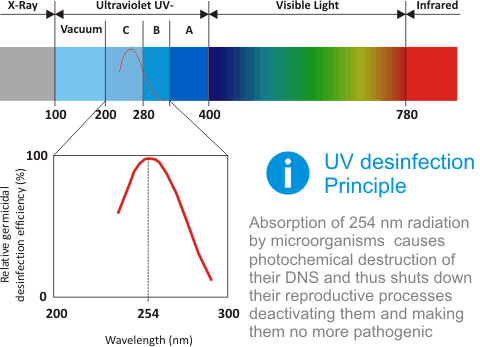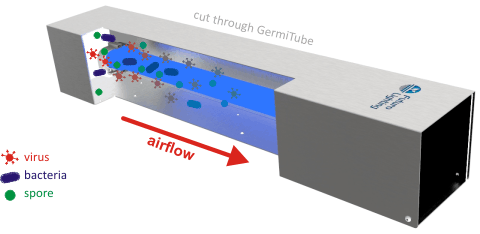
Ultraviolet (UV) radiation is invisible to the human eye. It occupies the portion of the electromagnetic spectrum between X-ray and visible light. The sun
emits ultraviolet light; however, much of it is absorbed by the earth’s ozone layer. Specific range of UV wavelengths, those between 200 and 300 nanometers,
are categorized as germicidal. This means, they are capable of inactivating microorganisms, such as bacteria, viruses and protozoa. This capability has allowed
widespread adoption of UV light as an environmentally friendly and highly effective way to disinfect air against harmful micro-organisms. Efficient disinfection
requires appropriate UV exposition given by exposure time and UV-C radiation dose. Practically speaking in times from few seconds till minutes and doses from
500 uW to few Wats.

GermiTube is used for disinfection of air contaminated by bacteria and viruses. Lamp uses UVC radiation with dominant wavelength of 254 nm. UV-C source is placed in air
tunnel with vent, where air is flowing through in close vicinity to UV-C source. Distance from lamp is short and gives high radiation intensity due to size of air tunnel
and reflective inner surface. Disinfection begins once air pass through the tunnel. GermiTube is designed to operate during presence of people, keeping UV-C radiation just
inside the tunnel. Because different bacteria and viruses needs different dose (UV-C intensity x time) user can adjust flow rate. To overcome needs to set-up standard
timers we have developed sensoric system, which monitors movement in front of the emitter. GermiTube operates always when people are present in a room, this excludes
complicated and non efficient lamp operation at time when it dos need to operate. Once last movement is detected (last person leaves) Germitube executes after disinfection
and prepare clean area are for a e.g. next day.


